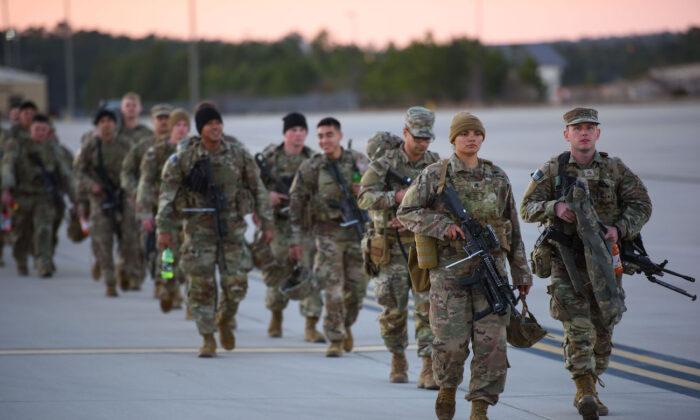The U.S. Army has indicated it is likely to significantly fall short of its target number of troops over the next two years amid what a top general said were “unprecedented challenges” in attracting, training, and retaining soldiers.
Army Gen. Joseph Martin, vice chief of staff for the Army, told a House military personnel panel on Tuesday that the projection for the estimated total number of troops in the force by the end of the 2022 fiscal year, Sept. 30, is 466,400.
Meanwhile, for the end of fiscal year 2023, the Army is projecting a troop size of between 445,000 and 452,000, Martin told lawmakers.
‘Unprecedented Challenges’
The Army’s number two officer told lawmakers it is striving to reach a troop size of 455,000 for the end of fiscal year 2023, but “the question is whether we can achieve it.”“Right now what we’re experiencing—the ”why“ of what we think is going on right now—is we’ve got unprecedented challenges with both a post-COVID-19 environment and labor market, but also private competition with private companies that have changed their incentives over time,” he told the House Armed Services subcommittee.
He also noted that only about 23 percent of the population are physically, mentally, and morally qualified to serve, and within that figure, a smaller number want to serve.
When asked about what the Army would need to do if it fell short of its goals in recruiting or retention, such as whether it would need to make cuts to its force structure, Martin said: “We don’t need to do that immediately.”
“But if we don’t arrest the decline that we’re seeing right now in end strength, that could be a possibility in the future, but we don’t see the need in the near term,” he added.
“In the near term, the way we’re going to manage any shortfalls is ways we’ve done it in the past, where we prioritize formations that have missions or preparation for missions and those missions will be prioritized to be manned.”
Vaccine Mandates Questioned
When asked about the vaccine mandates, Martin disputed that some 75,000 people were facing discharge for refusing to take the COVID-19 vaccine. He said the figure is “less than 20,000,” but noted: “it’s still a significant number and that’s why I’m looking forward to improvements.”Rep. Mike Johnson (R-La.), a member of the House Judiciary and Armed Services Committees, took to Twitter to advocate for the end of the COVID-19 vaccine mandate in the military, noting the drastic projected reductions in strength in the Army.
Recruiting Goal Not Met Despite Incentives
With just two and a half months to go in the 2022 fiscal year, the Army has achieved just 50 percent of its recruiting goal of 60,000 soldiers, according to a spokeswoman for Army Secretary Christine Wormuth, Lt. Col. Randee Farrell, per The Associated Press.“The Army is facing our most challenging recruiting environment since the inception of the all-volunteer force. This is not a one-year challenge. We will not solve this overnight,” Wormuth said, reported the news agency. She added that the service is looking at a wide range of steps to recruit more soldiers without lowering standards or sacrificing quality.
“We are facing a very fundamental question,” she added. “Do we lower standards to meet end strength, or do we lower end strength to maintain a quality, professional force? We believe the answer is obvious—quality is more important than quantity.”
Military leaders have been spending tens of thousands of dollars in increased bonuses as incentives for recruits, hoping to compete with other employers around the country. The unemployment rate is about 3.6 percent.
In January, the Army, for the first time, began offering a maximum enlistment bonus of $50,000 to highly skilled recruits who join for six years.






Friends Read Free